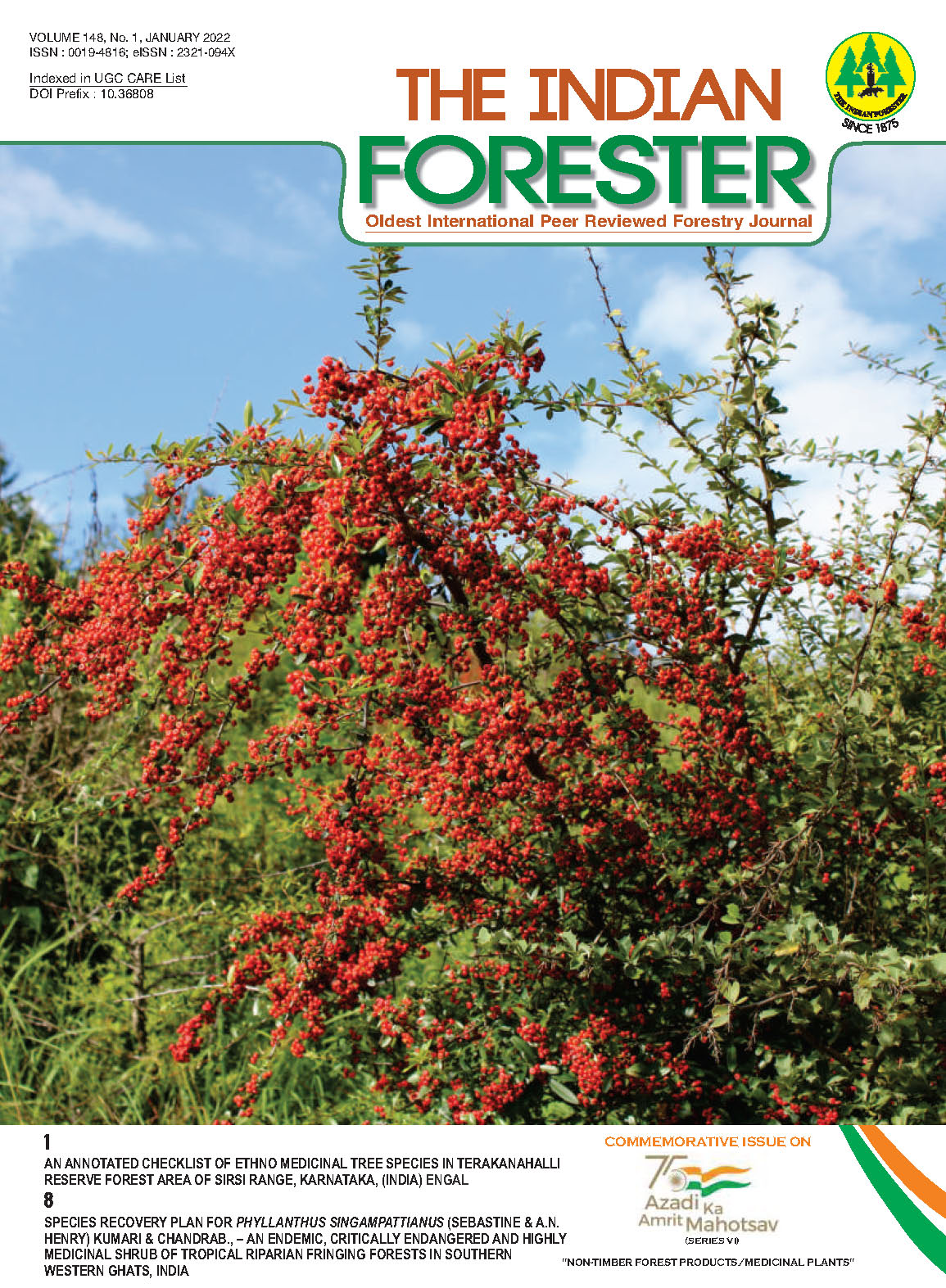Ethnomedicinal Plants of Amchang Wildlife Sanctuary, Assam, North Eastern India
DOI:
https://doi.org/10.36808/if/2022/v148i1/151059Keywords:
Assam, Ethnomedicine, Kamrup Metro, North Eastern India, Protected Area.Abstract
Knowledge related to ethnomedicinal uses to treat various ailments provide an important alternative to unavailable or expensive medicine in many rural/marginal communities. Ethnomedicinal studies have received much attention in recent years due to their wide local acceptability and clues for new or lesser known medicinal plants. Large numbers of ethnobotanical studies of protected areas of Assam have been carried out by several workers but there is no study from the selected study site i.e., the Amchang Wildlife Sanctuary. For the present study, ethnomedicinal uses of the plants were assessed through informal semi-structured questionnaire involving the local people inhabiting in fringe of the wildlife sanctuary during the year 2016 to 2018. Altogether 111 plant species belonging to Pteridophyte (14 plant species), Gymnosperm (1) and Angiosperm (96) were collected from Amchang Wildlife Sanctuary which were used by fringe community as medicine for treating various ailments. These ethnomedicinal plants were enumerated alphabetically with scientific name, local name, family and part used with their associated medicinal values. If commercially cultivated and properly managed, these could open the corridors for generating income and employment opportunities for the local people and also provide a sustainable land use system for the wastelands and degraded forests.References
Ali N. and Ghosh B. (2006). Ethnomedicinal plants in Arunachal Pradesh: Some tacit prospects. ENVIS Bullentin: Himalayan Ecology, 14(2): 19-24.
Benny K.H.T. and Vanitha J. (2004). Immunomodulatory and Antimicrobial Effects of Some Traditional Chinese Medicinal Herbs: A Review. Current Medicinal Chemistry, 11: 1423-1430.
Bor N.L. (1940). Flora of Assam (Gramineae) 4. Govt. of Assam.
Borah S.M., Borah L. and Nath S.C. (2012). Ethnomedicinal plants from Disoi Valley Reserve Forest of Jorhat District, Assam. Plant Sciences Feed, 2(4): 59-63.
Changkakati T. (2017). Forest cover change in Amchang Wildlife Sanctuary, Assam, India. Journal of Engineering Technology, 6(2): 2348-7305.
Craig W.J. (1999). Health-promoting properties of common herbs. American Journal of Clinical Nutrition, 70(3): 491S499S.
Das C. and Teron R. (2014). Ethnobotanical notes of the Rabha community in Mataikhar reserve forest of Kampur district, Assam, India. Research Journal of Recent Sciences, 3(6): 2633.
Das S., Khan K.L., Rabha A. and Bhattacharya D.K. (2009). Ethnomedicinal plants of Manas National Park, Assam, North east India. Indian Journal of Traditional Knowledge, 8(4): 514517.
Gadgil M. (1996). Documenting diversity: An experiment. Current Science, 70(1): 36-44.
Hooker J.D. (1872-1887). Flora of Bristish India 1-7. Lovell, Reeve and Co, London.
Jain S.K. (1991). Dictionary of Indian Folk Medicine and Ethnobotany. Deep Publishers, New Delhi.
Jain S.K. and Mudgal V.A. (1999). Hand Book of Ethnobotany. Bishan Singh Mahendra Pal Singh, Dehra Dun.
Kala C.P. (2005). Ethnomedicinal botany of the Apatani in the Eastern Himalayan region of India. Journal of Ethnobiology and Ethnomedicine, 1(11): 1-12.
Kanjilal U.N., Kanjilal P.C., Das A. and Purkayastha C. (1934).
Flora of Assam 1. Bishan Singh Mahendra Pal Singh, Dehra Dun.
Kanjilal U.N., Kanjilal P.C. and Das A. (1936). Flora of Assam 2. Bishan Singh Mahendra Pal Singh, Dehra Dun.
Kanjilal U.N., Kanjilal P.C., Das A. and De R.N. (1938). Flora of Assam 3. Bishan Singh Mahendra Pal Singh, Dehra Dun.
Kar A., Borah B. and Goswami N. (2015). Inventorization of vascular plant diversity in Amchang Wildlife Sanctuary, Kamrup Metro district, Assam. Indian Journal of Applied research, 5(2): 48-60.
Khan Z.S., Khuroo A.A. and Dar G.H. (2004). Ethnomedicinal survey of Uri, Kashmir Himalaya. Indian Journal of Traditional Knowledge, 3(4): 351-357.
Kumar A., Meena D.K., Medhi A., Baruah B. and Das D.J. (2018). Traditional ethno-medicinal knowledge of Mishing tribes residing in the core zone of Dibru-Saikhowa National Park, Assam, India. Journal of Medicinal Plants Studies, 6(2): 77-80.
Kutum A., Sarmah R. and Hazarika D. (2011). An ethnobotanical study of Mishing tribe living in the fringe villages of Kaziranga National Park of Assam, India. Indian Journal of Fundamental Applied Life Sciences, 1(4): 45-61.
Namsa N.D., Mandal M.M., Tangjang S. and Mandal S.C. (2011). Ethnobotany of the Monpa ethnic group at Arunachal Pradesh, India. Journal of Ethnobiology and Ethnomedicine, 7: 31-45.
Purkayastha J., Dutta M.L. and Nath, S.C. (2007). Ethnomedicinal plants from Dibru-Saikhowa Biosphere Reserve. Indian Journal of Traditional Knowledge, 6(3): 477-480.
Ragupathy S., Steven N.G., Murugesan M., Balasubramaniam V. and Ul-Huda, M.M. (2008). Consensus of the 'Malasars' traditional aboriginal knowledge of medicinal plants in the Velliangiri holy hills, India. Journal of Ethnobiology and Ethnomedicine, 4: 8.
Saklani A. and Jain S.K. (1994). Cross cultural ethnobotany of North-East India. Deep Publishers, New Delhi.
Sarkar M. and Devi A. (2017). Analysis of medicinal and economic important plant species of Hollongapar Gibbon Wildlife Sanctuary, Assam, North east India. Tropical Plant Research, 4(3): 486-495.
Sen P., Dollo M., Choudhury M.D. and Choudhury D. (2008). Documentation of traditional herbal knowledge of Khamptis of Arunachal Pradesh. Indian Journal of Traditional Knowledge, 7(3): 438-442.
Talukdar S. and Gupta A. (2014). Medicinal plants used by the Bodo community of Chakrashila Wildlife Sanctuary, Assam, India. Indian Journal of Applied research, 4(2): 1-4.
Tripathi Y.C. (2000). Ethnomedicinal treasure of tribal Rajasthan. Journal of Non Timber Forest Products, 7(1&2): 7784.
Yumnam J.Y. (2008). Rich biodiversity of Northeast India needs conservation. Current Science, 95(3): 297.
Yumnam J.Y. (2012). A unique way of using washcloth dyed with bixin by the Meiteis of Manipur. Current Science, 102(12): 1621.
Yumnam J.Y. and Tripathi O.P. (2012). Traditional knowledge of eating raw plants by the Meitei of Manipur as medicine/nutrient supplement in their diet. Indian Journal of Traditional Knowledge, 11(1): 45-50.
Yumnam J.Y. and Tripathi O.P. (2013). Ethnobotany: Plants use in fishing and hunting by Adi tribe of Arunachal Pradesh. Indian Journal Traditional Knowledge, 12(1): 157-161.
Yumnam J.Y., Bhuyan S.I., Tripathi O.P. and Khan M.L. (2011). Study on ethno-medicinal plants used by Adi tribe of East Siang district, Arunachal Pradesh. Journal of Economic and Taxonomic Botany, 35(2): 369-377.
Downloads
Downloads
Published
How to Cite
Issue
Section
License
Unless otherwise stated, copyright or similar rights in all materials presented on the site, including graphical images, are owned by Indian Forester.





